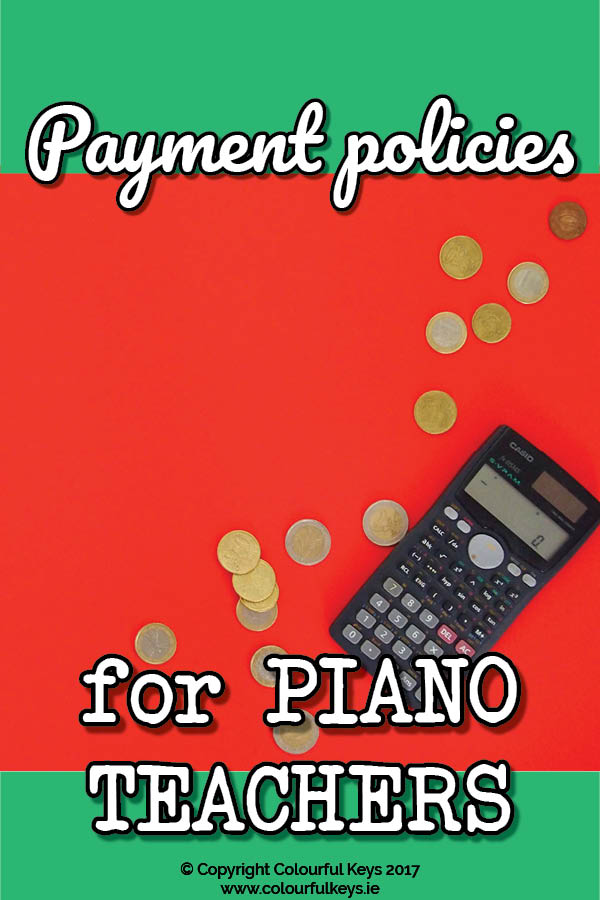It’s time to tackle your favourite topic: payment policies for piano teachers.

Seriously though, with how much this comes up in piano teaching communities, you actually would think that we simply LOVE talking about payment policies!
Whether you love ‘em or loath ‘em, you will need to find the right payment option for your studio. Let’s walk through the three basic types so you can decide what the best choice is for you.
Per-lesson Payments
If you read many piano teaching blogs, you might think that this type of payment structure was dead and gone. But I think it’s still pretty prevalent in our industry.
I’m including in this bracket any payments that are based on specific lessons, whether the student:
- Pays at each individual lesson
- Is billed at the end of the month for the lessons they attended
- Buys a block of 4 lessons and then another block of 4 when those have been used up
All of these payment policies rely on a per-lesson fee. Put simply, this is a bad idea, but I’ll break down the pros and cons nevertheless.
Pros of Per-lesson Payment Policies for Piano Teachers
- It’s simple.
That’s about it…
Cons of Per-lesson Payment Policies for Piano Teachers
- If students don’t show up, you won’t get paid. (You can put cancellation policies in place…but they’ll never be reliable.)
- Students perceive that they are simply paying you for the time they’re receiving.
- Students/parents have to regularly find exact amounts in cash or write a bunch of cheques, which isn’t convenient for anyone.
Flat Monthly Fees
Ok, now on to the good options.
Charging a flat monthly fee means that parents/students are paying the same amount each month for being a part of your studio.
This fee is often based on the number of lessons in the year but it remains the same whether there are 2 lessons in a month or 5. A flat monthly piano lesson fee can also factor in other benefits of your studio such as group workshops, recitals, lending libraries, prizes or any other goodies.
Pros of Flat Monthly Fee Payment Policies for Piano Teachers
- It’s easy for parents to remember how much they owe.
- It reduces the expectation of make-up lessons and reschedules.
- Your income remains steady month-to-month.
Cons of Flat Monthly Fee Payment Policies for Piano Teachers
- It may require some parent education to get them on-board.
- If accepting cash or cheques you will need to deposit them quite regularly.
- If students quit there’s no way to hold them to the next month’s payment. (You can try, but are you really going to be able to fight them over it if they refuse?)
Semester/Term Based Fees
This last option really could be perceived as a per-lesson fee by parents/students if you don’t treat it carefully.
When charging by the semester or term you should still emphasise all the benefits of enrolling in your studio, and you should not explicitly mention how many lessons this fee is covering.
If you’re doing that, the pros and cons are very similar to monthly tuition fees.
Pros of Semester Based Fee Payment Policies for Piano Teachers
- You’re guaranteed a longer commitment to your studio.
- You have to chase and lodge payments less often.
- It reduces the expectation of make-up lessons and reschedules.
Cons of Semester Based Fee Payment Policies for Piano Teachers
- Parents may find it difficult to pay such a large chunk in one go.
- You need to budget carefully as you’ll be receiving your income in 2-4 large waves per year.
- There may be more follow-up to get paid since it happens so irregularly.
Which of these payment policies for piano teachers is the right one?
That depends on you and your community.
In my studio I offer both flat monthly and semester based payment options. I give a slight discount for the semester payments to account for the longer commitment and the reduced admin work on my end.
Think through each of these options and then go with your gut. It’s usually right about these sorts of things.
Which did you choose?
Let me know in the comments or in the Vibrant Music Studio Teachers group on Facebook what type of payment structure you follow in your studio right now, and how it’s working out for you.

Hello, Nicola. This is a great summary–thank you! I think you cut-and-pasted the pros and cons under monthly payments, as they still say ‘per-lesson’. I hope you are having a lovely vacation!
Thanks Patricia, yes I realised as soon as it published but was up in Belfast so just fixed it now.
My students pay for the entire month at the first lesson of every month. Students with 30 minute lessons pay based on a 4 or 5 week month. Occasionally, someone will text and ask how much they owe but parents catch on pretty fast. Students with 45 minute lessons pay a flat monthly fee and are not charged extra for 5 week months. I structure it this way for a reason. The difference between a 5 week 30 minute lesson and a 45 minute lesson is only $10 in my studio. Knowing this makes the financial transition from 30 to 45 minute lessons easier for most families. I do one make up lesson a semester if a student has a 30 minute lesson and is sick. If something comes up and I have an opening later in the week, I switch them to that time if I have something available. I RARELY do make up lessons. Because of the way my prices are structured. I do not do make up lessons for students with a 45 minute lesson. The fifth week is considered the week for make up lessons and if they don’t need a make up lesson, it is a free lesson. Presented that way, most people choose a 45 minute lesson. My fees are not the highest in my community but they are higher than most of the other teachers. I have a waiting list and my higher fees are not a problem. Also, if I have time and a student needs a longer lesson, I hold them over if the parent is willing to wait. I keep a record of this extra free time when I mark attendance. Parents know I keep up with it. If a student misses and needs a make up lesson, quite often, over the course of a few months, I’ve already given them that time in advance. That way, students get the time when they need it most. One adult student recently started paying me more without me asking for an increase in fees. Another parent paid me for the week I was on vacation because she knows I give a little extra time when her daughter needs it. As trust and relationships develop, people know that I care. I do mobile deposits with checks using the camera on my phone. Most checks are easily deposited within 24 hours.
Hello Nicola, this was a great post! Right now I have my students paying for the whole month, either 4 or 5 weeks, at the first lesson of each month. However, I have tried to put cancellation policies in place, but I have had a really hard time holding people accountable to them! And people cancel or reschedule pretty frequently. I like your pros and cons list and am definitely going to rethink my payment plan. I’m curious to see what more teachers are doing as well. Thanks for the tips!
It is hard to hold people to that when they are paying per-lesson. You might like this other post Desirae to help you get rid of makeups. https://colourfulkeys.ie/leave-make-up-lessons-in-the-dust-with-these-two-pivots/
Yes, I was just reading that post as well! It is very helpful. Thank you!
I do have a question about the monthly flat-rate option…how do you take into account if you, the teacher, is going to be out of town or is sick during a lesson?
I’ll refund the cost/charge less that month if I know in advance. It’s rare for me though. If it happens more regularly for you I would bring in holiday weeks as part of your calculations, i.e. charge for 38 lessons but schedule 40 and take the two weeks when you need to.
I have been using the monthly payment option. However, I’ve had some issues lately when a student has asked to switch their lesson to a different day. How do you deal with recalculating the fees going forward and making sure what they’ve paid to date is balanced with how many lessons they’ve had? for example, the first time they switched, I totaled how many lessons they had had so far and compared that to what they had paid so far. They owed me, so I billed them for that. Then I recalculated their new monthly fee based on how many lessons were left in the year using their new lesson day. Is that what I should be doing?
Yes, if it changes things. However, if they just change lesson day it shouldn’t change the number of lessons left…unless you have different numbers of each day in your calendar?
If everything is included, ie, recitals, group classes, etc, how do you calculate the monthly flat fee? Thanks!
Hi Amber,
Check out our Monthly Rate Calculator, this could be just the tool you need!
https://colourfulkeys.ie/music-lesson-rates/#monthly
Warm Regards,
Gemma – Colourful Keys Community Assistant
Hi there,
Just a quick question, I checked your pricing chart so pricing for at-home lessons first student is $194 for 60mins and $158 for an additional student. so do you mean both students would be taught at the same time? just like a partner class? how does this work, I am just trying to understand here. can you please explain this? thanks.